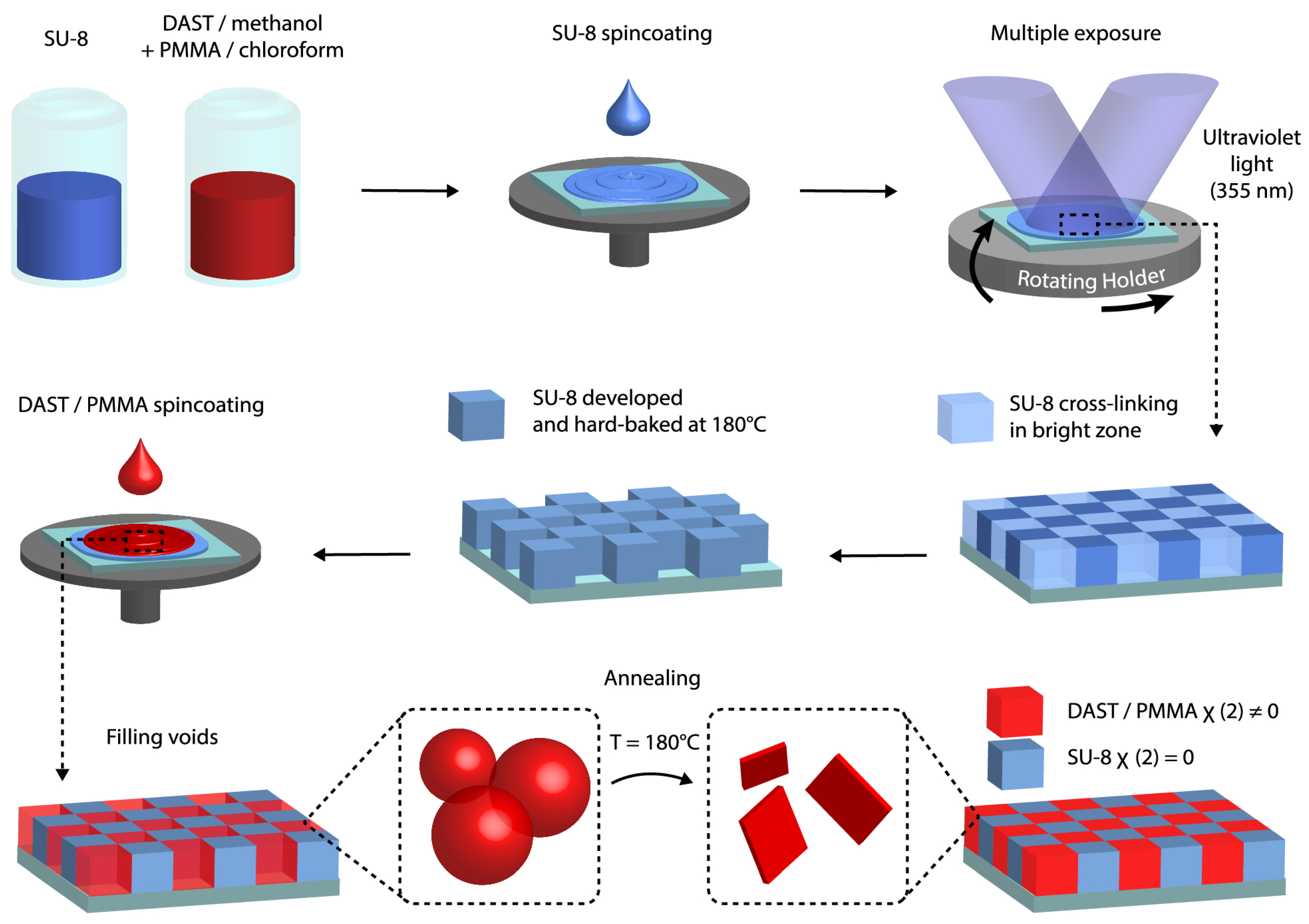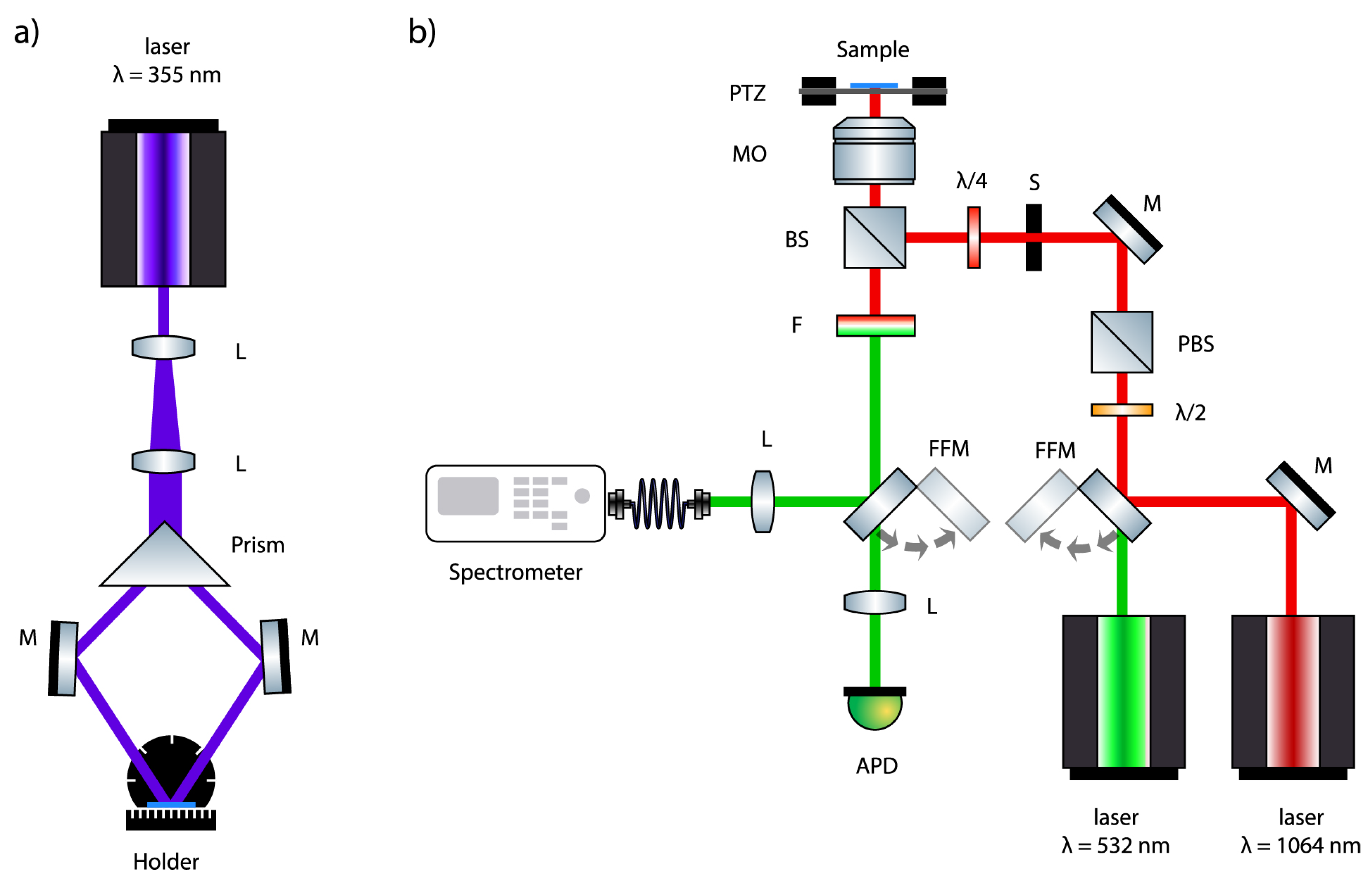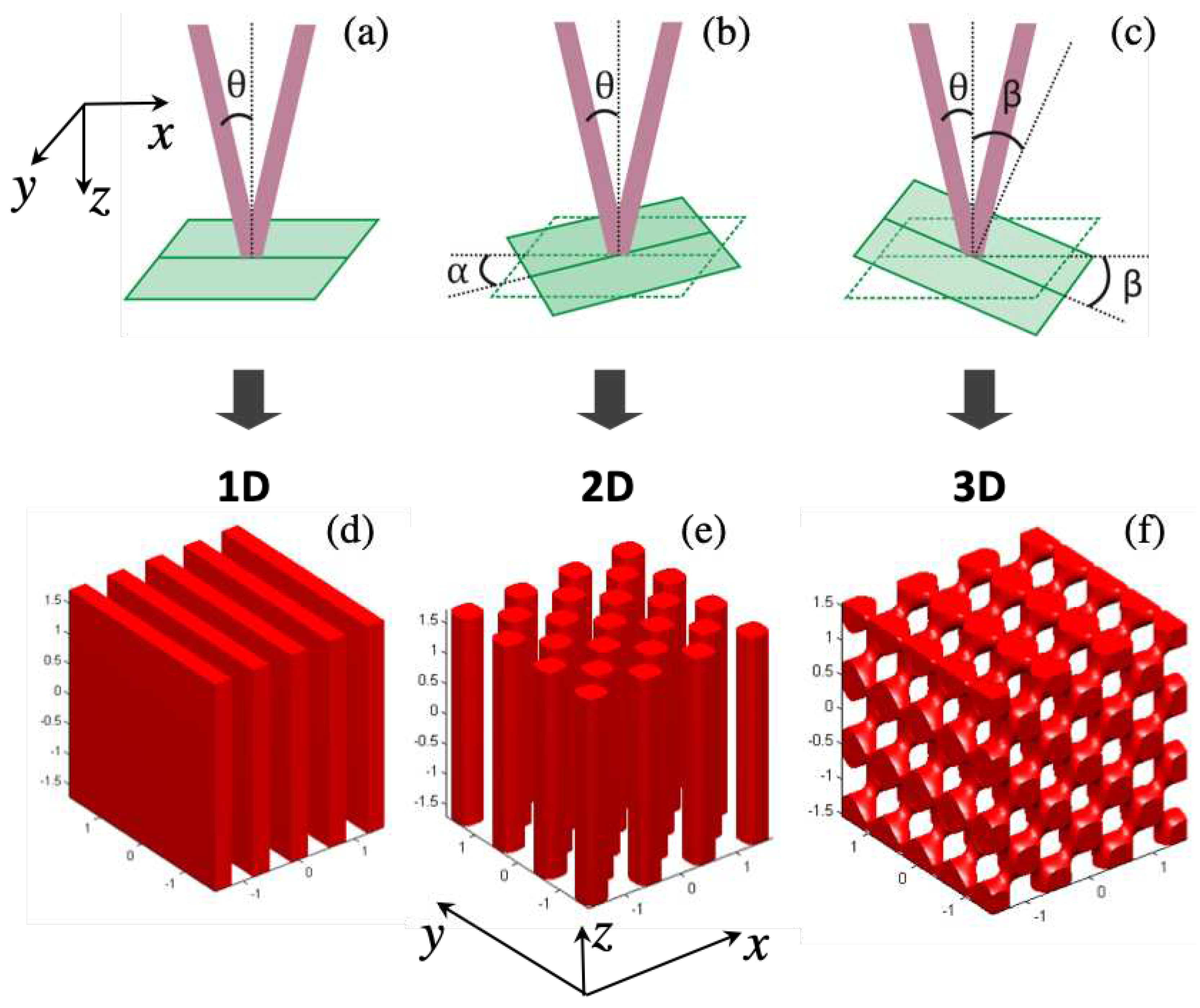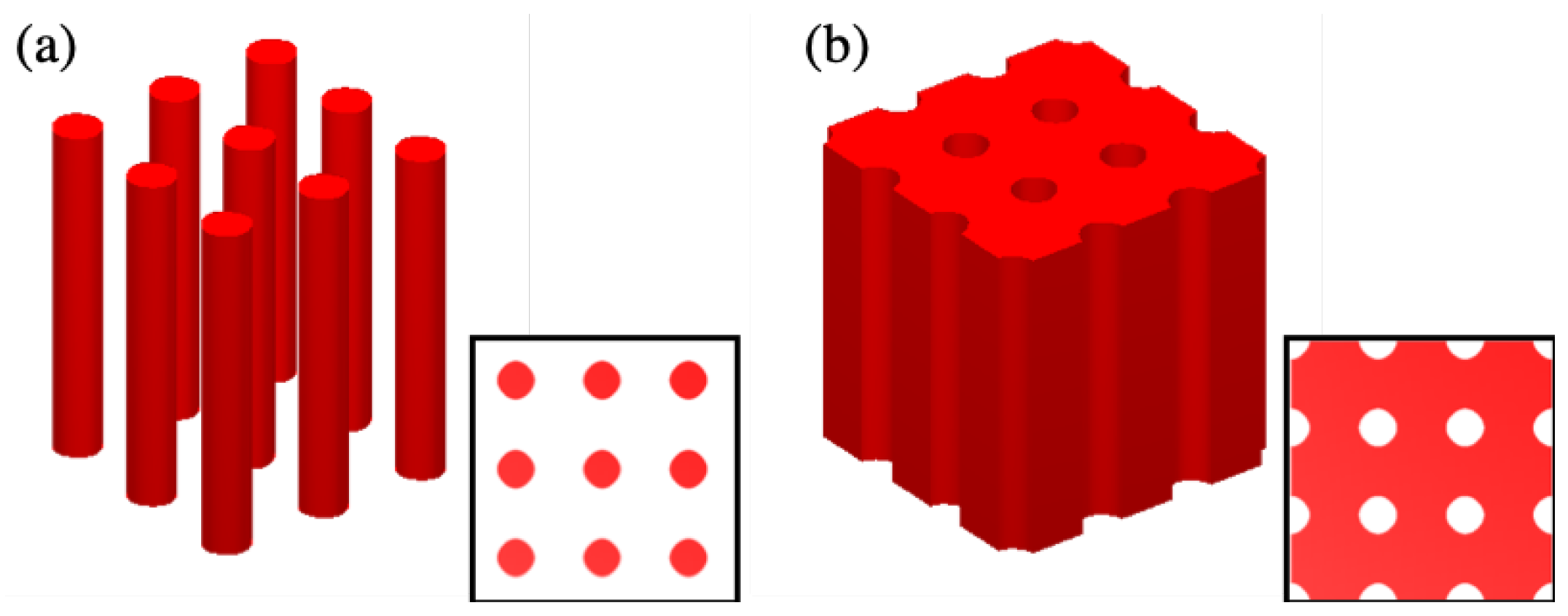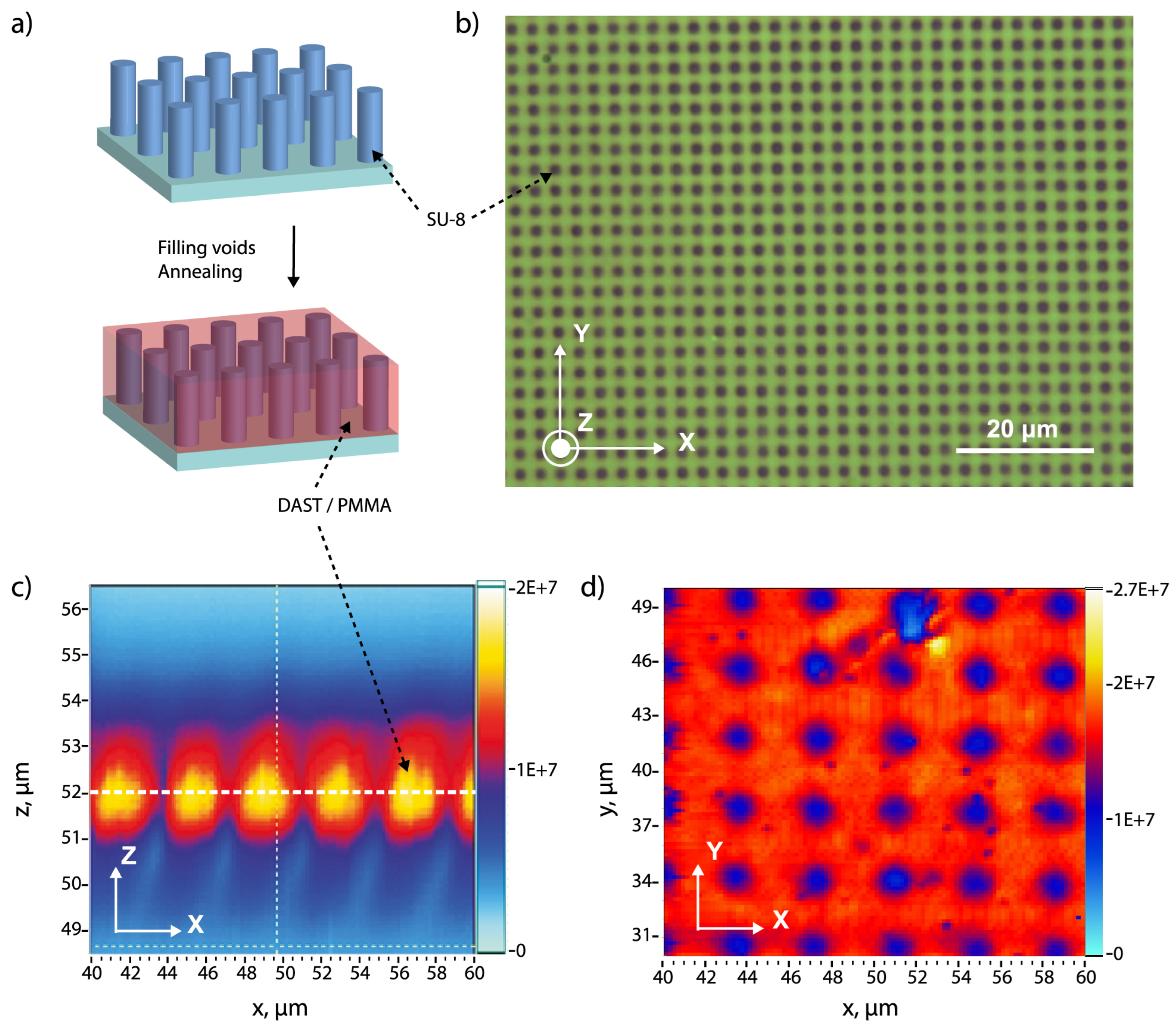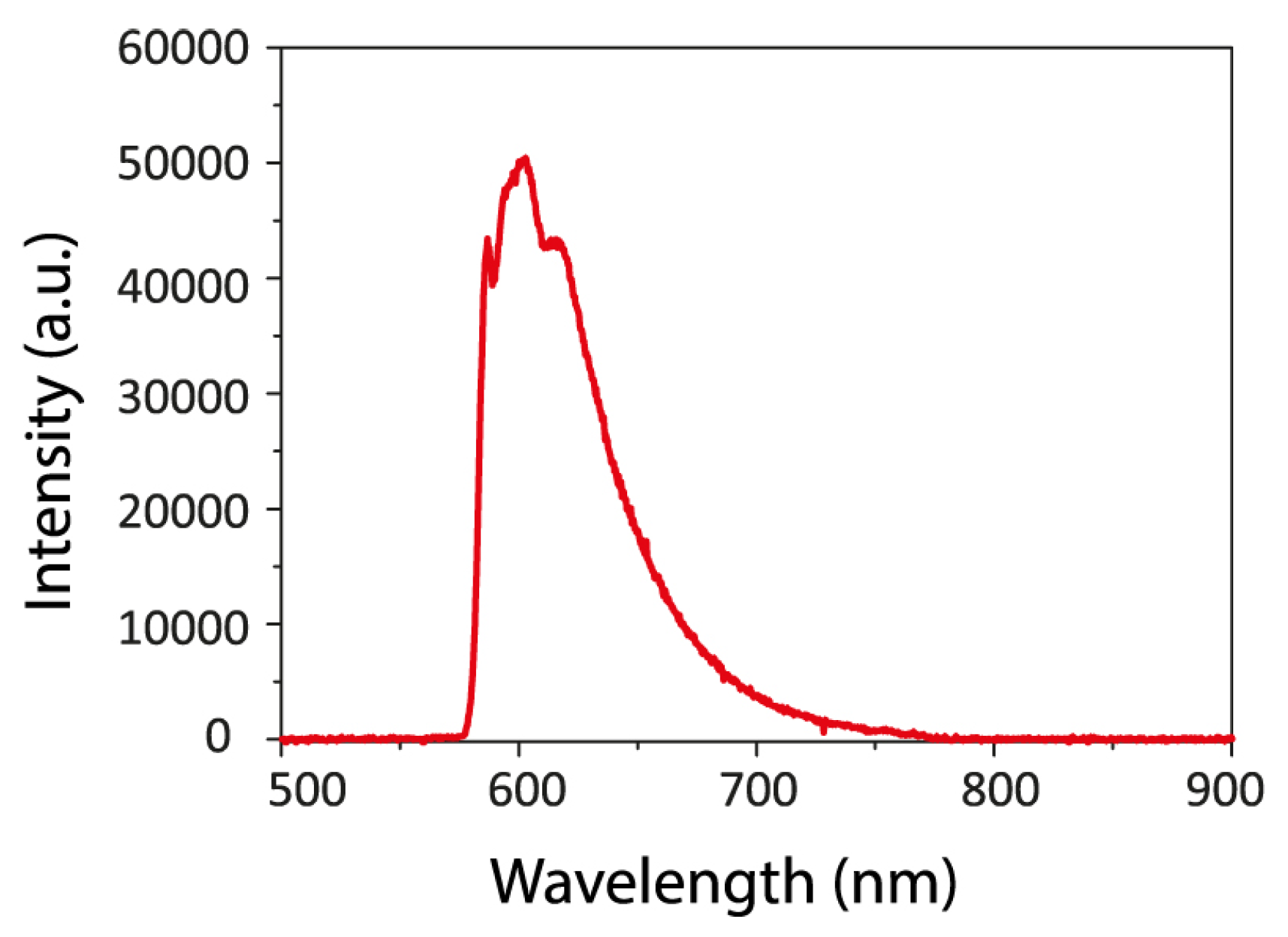1. Introduction
Within the last ten years, the field of terahertz (THz) science and technology has developed greatly. Many new and promising advances in the technology for the generation, manipulation, and detection of THz radiation have been made. The most important task is the development of the new materials and technology for THz generation and detection [
1]. Optical rectification in electro-optical crystals has been demonstrated as the best technique for generating subpicosecond, THz bandwidth radiation [
2]. For THz application, the three most important requirements for nonlinear optical crystals are i) high nonlinear coefficient, ii) low absorption of THz irradiation by the crystal, and iii) phase matching between pump and THz waves propagations.
Several groups in the world have examined different nonlinear materials for THz emission by optical rectification. These materials include organic salts such as dimethyl amino 4-N-methylstilbazolium tosylate (DAST) [
3], dielectric inorganic electro-optical materials like LiTaO
3, and semiconductors such as GaAs and GaP. Among them, DAST is the most efficient THz rectification material [
5], due to its large electro-optics (EO) coefficient and its low dielectric constant (
), giving rise to a high modulator figure of merit [
5]. Indeed, according to data in [
6], DAST exhibits a huge second-order nonlinear optical susceptibility
pm/V at
nm and its corresponding electro-optical figure of merit being
pm/V at
nm. However, phase matching between optical wave and THz radiation propagation, a major factor determining the efficiency and the bandwidth of THz emission from nonlinear crystal, is still a challenge. Actually, only few electro-optical crystals possessing a long coherence length is suitable for THz generation. Most nonlinear materials possess a coherence length in a range of few micrometers to dozens of micrometers, thus limiting the THz generation efficiency. It is necessary to find out a way to solve the problem of phase mismatch in DAST crystals.
Quasi-phase matching (QPM) is a technique which compensates the phase mismatch of nonlinear processes by creating a grating of spatially modulated nonlinear properties with a period corresponding to twice of coherence length. Typically, the QPM structures have periods in the range of few micrometers to dozens micrometers, which is quite easy to be realized today. In a quasi-phase matched structure, the interaction length between THz and pump pulses can be dramatically extended to centimeters range. For example, QPM structures were used for the generation of THz wave packets with tunable central frequency [
7] or for the generation of multicycle narrow-bandwidth THz radiation based on phase synchronous optical rectification [
8]. It is clear that nonlinear gratings or QPM structures may provide an efficient control of THz generation.
Conventionally, the QPM effect is obtained in a nonlinear material in which the nonlinear property is modulated between negative and positive signs (+/- QPM). However, this is not easy to realize in practice, in particular for three-dimensional (3D) QPM structures. An alternative way to achieve the same effect is to combine the nonlinear material with a linear material, corresponding to a periodical modulation of
between zero and non-null value (+/0 QPM). The theoretical model of this particular QPM structure was presented in our recent work [
9] for a general nonlinear optical effect. Very few works have been demonstrated to realize these +/0 QPM structures. For example, one of our old works [
10] demonstrated a layer-by-layer direct laser writing technique to obtain a polymeric 3D QPM structure. This technique has been applied for copolymer nonlinear material requiring an additional poling technique, since the copolymer is centrosymmetric. It could be applied for patterning DAST nanocrystals as well. However, this technique requires spin-coating of different materials layer by layer and thus very time consuming, and imprecise in term of periodicity. Recently, two other groups experimentally demonstrated a direct fabrication by employing a femto-second laser based bleaching technique [
11,
12] in LiNbO
3 material. We also applied this technique to patterning DAST nanoscrystals structures, as shown in reference [
15]. This direct technique allows to solve the problem of imprecision, but again, it does not produce a large QPM structure in a short time.
There are different methods to realize QPM structures based on DAST nonlinear material. However, DAST requires a customized approach, because DAST material is usually fabricated in the form of micro- and nanoparticles. By using the assembling of multiple layer technique, DAST/SiO
2 multilayers has been proposed for THz generation [
13]. We can see that QPM elements based on DAST and SiO
2 micrometer-size layers can be effective for THz generation, but their fabrication is still a great challenge. In our recent work, we have demonstrated a way to obtain desired DAST structures by mixing DAST nanocrystals with a passive polymer matrix. Indeed, we have successfully obtained a nonlinear nanocomposite based on DAST nanocrystals embedded in a PMMA polymer matrix and showed that the nonlinear conversion efficiency doesn’t depend on the DAST crystals size [
14]. We have also fabricated 2D grating structures by photobleaching DAST nanocrystals using a technique called one-photon absorption based direct laser writing [
15]. The last one is very efficient but rather slow and therefore time consuming. Very recently, we proposed an alternative method by combining a mask lithography and thermal annealing to produce
QPM DAST structure [
16]. Highly efficient THz generation by this DAST nanocomposite is demonstrated upon excitation by femtosecond pulses and generation by the method of optical rectification. However, since the mask technique was used, it is not suitable to adjust the structures configurations and periodicity, and also it is not possible to produce small periods and 3D structures.
In this work, we demonstrated an alternative way to fabricate DAST/polymer large structures in a short time, which is based on filling a holographically fabricated SU-8 template by a DAST-PMMA composite.
Figure 1 shows the fabrication process of desired DAST/polymer structures. First, this method consists in the preparation of the SU-8 template by an interference technique [
17], which has many advantages such as rapidity, simplicity, large and uniform structures. Second, the DAST-PMMA composite is spin-coated into SU-8 template and thermally annealed to remove the solvent and to induce DAST crystallization. The final result is a linear/nonlinear structure having a controllable period and desirable configurations, which is equivalent to a
QPM structure, and which could be useful for THz generation. We demonstrated the nonlinear properties of these fabricated structures by measuring the second-harmonic generation (SHG) signals.
4. Results and discussion
To demonstrate the idea of our proposal, we fabricated different 2D SU-8 templates by using the multiple-exposure two-beam interference technique with a period of
m. The fabrication of 2D structure depends on the number of exposures and on sample orientation with respect to each exposure [
17]. For example, two mutually perpendicular positions of the sample allowed us to fabricate 2D square structures, as shown in
Figure 5b. By using a modest exposure dose (2,1 mW/cm
2 per interference beam and 2 seconds for each exposure), this fabricated structure is made of SU-8 pillars, as modelling by the simulation, which is shown in
Figure 5a.
Figure 5c–d shows the fluorescence mapping image of the final sample, after filling the air-areas of the SU-8 template by the DAST nanocrystals. It is well seen that SU-8 pillars with a weak fluorescence signal are surrounded by DAST/PMMA composite, where DAST crystals show a fluorescence quantum yield of
[
23] and provide a strong fluorescence signal. By scanning the sample along transverse and longitudinal directions, we obtain complete information,
the structure thickness and periodicity. The sample thickness agrees well with the value measured by a profilometer, and the structure period is also very consistent with the designed structure. The fluorescence spectrum of DAST/PMMA area (
Figure 6) shows typical fingerprint of DAST crystals with noncentrosymmetric “red-green” form [
24].
Similar to the fluorescence experiment, when using a 1064 nm pulsed laser, we obtained the SHG mapping image of corresponding sample.
Figure 7 shows the SHG wavelength and mapping image. A clear peak at 532 nm was obtained as a proof of the nonlinear property (SHG) of the DAST nanocrystals.
Figure 7b shows that the SH signal is very high from DAST nanocrystals, as compared to the weak signal from SU-8 pillars. Thus, a periodic linear/nonlinear microstructure has been demonstrated by this scanning method. The advantage of this structure as compared to those fabricated by other methods [
15] is that there exists a clear border between linear (SU-8 photoresist) and nonlinear (DAST nanocrystal) responses, and the structure is also very large, since it was realized by the interference method, for which the structure area depends on the diameter of the interference laser beam. Unfortunately, we cannot realize QPM measurements with these samples since the film thickness is only
m. However, this work demonstrates that the combination of interference template and thermal annealing method is an excellent way to obtain rapidly large QPM structures. We expect to investigate this method for 3D QPM, and apply it for efficient THz generation.
Figure 1.
Fabrication process of +/0 QPM structure by filling voids of a photoresist template with DAST nonlinear material. The template is fabricated by the multiple-exposure two-beam interference technique. The DAST nanocrystals are obtained by the thermal annealing method.
Figure 1.
Fabrication process of +/0 QPM structure by filling voids of a photoresist template with DAST nonlinear material. The template is fabricated by the multiple-exposure two-beam interference technique. The DAST nanocrystals are obtained by the thermal annealing method.
Figure 2.
(a) Two-beam interference setup used for the fabrication of multidimensional polymeric templates. L: lenses, M: mirrors. Sample is placed in a holder which can rotate in two dimensions for multiple exposures; (b) Confocal laser scanning setup used for the characterization of QPM structures. PZT: piezoelectric translator, MO: microscope objective, : quarter-wave plate, : half-wave plate, BS: beam splitter, PBS: polarizing beam splitter, M: mirror, FFM: flip-flop mirror, S: electronic shutter, L: lens, F: infrared filter, APD: avalanche photodiode.
Figure 2.
(a) Two-beam interference setup used for the fabrication of multidimensional polymeric templates. L: lenses, M: mirrors. Sample is placed in a holder which can rotate in two dimensions for multiple exposures; (b) Confocal laser scanning setup used for the characterization of QPM structures. PZT: piezoelectric translator, MO: microscope objective, : quarter-wave plate, : half-wave plate, BS: beam splitter, PBS: polarizing beam splitter, M: mirror, FFM: flip-flop mirror, S: electronic shutter, L: lens, F: infrared filter, APD: avalanche photodiode.
Figure 3.
Illustration of –angle (a), which is half of angle between two beams, and rotation angles (b) and (c). Matlab simulations of iso-intensity distribution () of two-beam interference with nm, : (d) one exposure with ()=(); (e) two exposures with ()=() and (); (f) three exposures with ()=(), () and (), respectively.
Figure 3.
Illustration of –angle (a), which is half of angle between two beams, and rotation angles (b) and (c). Matlab simulations of iso-intensity distribution () of two-beam interference with nm, : (d) one exposure with ()=(); (e) two exposures with ()=() and (); (f) three exposures with ()=(), () and (), respectively.
Figure 4.
Matlab simulations of iso-intensity distribution of two-beam interference with nm, and with two exposures with ()=() and (), respectively. (a) “Cylinders” structure obtained with an . (b) “Air-holes” structure obtained with an .
Figure 4.
Matlab simulations of iso-intensity distribution of two-beam interference with nm, and with two exposures with ()=() and (), respectively. (a) “Cylinders” structure obtained with an . (b) “Air-holes” structure obtained with an .
Figure 5.
(a) Simulation of the photoresist structure; (b) optical microscope image of SU-8 2D square structure fabricated by two-beam interference method. The black/grey color represents the SU-8 pillars; (c) and (d) Fluorescence mapping images of fabricated sample by using a cw 532 nm laser beam. (c) Scanning along -plane; (d) Scanning along -plane at a z-position as marked by the white dashed line of the image shown in (c).
Figure 5.
(a) Simulation of the photoresist structure; (b) optical microscope image of SU-8 2D square structure fabricated by two-beam interference method. The black/grey color represents the SU-8 pillars; (c) and (d) Fluorescence mapping images of fabricated sample by using a cw 532 nm laser beam. (c) Scanning along -plane; (d) Scanning along -plane at a z-position as marked by the white dashed line of the image shown in (c).
Figure 6.
Fluorescence spectra of DAST nanocrystals in 2D structure, obtained by exciting at 532 nm wavelength. In this experiment, a filter having a cut-off wavelength of 580 nm was used.
Figure 6.
Fluorescence spectra of DAST nanocrystals in 2D structure, obtained by exciting at 532 nm wavelength. In this experiment, a filter having a cut-off wavelength of 580 nm was used.
Figure 7.
SHG of DAST nanoparticles embedded in a 2D periodic structure, obtained by using a fundamental laser beam at 1064 nm. (a) SHG spectrum. (b) SH mapping image obtained by scanning the sample in -plane.
Figure 7.
SHG of DAST nanoparticles embedded in a 2D periodic structure, obtained by using a fundamental laser beam at 1064 nm. (a) SHG spectrum. (b) SH mapping image obtained by scanning the sample in -plane.
